Since I couldn’t be joining the swathes of NRL fans on Caxton street this season, I decided to spend my valuable weekend time cataloguing which colour and brand of boots every NRL player wore at Magic Round. If there’s useless information I can track and create content out of, you can bet I’m going to do so.
Whilst that sounds like a significant time investment, it’s not the first time I’ve done it so I’ve managed to build some economies of scale into the process. After a while you start to recognise the design language each brand uses, as well as their colour palettes and it becomes much easier to spot what each player is wearing.
The feed of pre-game warm ups in the sheds that Fox League provides is also invaluable in saving time, as you can usually see the nearly the whole team at once. It also helps record interchange players in one go, rather than finding which minute they entered the field.
Here’s the count of players by brand from Magic Round this season compared to the last time I did this analysis, Round 14, 2021.

One thing that has changed from a brand perspective is the composition of brands represented in the game. Two seasons ago we had just five brands visible – Nike, Asics, Adidas, Puma, X Blades and Concave.
We’re now up to seven (technically eight, see below) different brands represented, with one leaving the field.
Asics have really increased their market share here, moving from 115 to 140 players wearing their boots. Please keep in mind that I’m looking at just the teams playing this weekend (sorry Knights fans), so it’s a valid 16 v 16 team comparison.
Every other brand has seen a drop in numbers from 2021 to 2023 except for Concave. Here’s the percentage share breakdown by season.
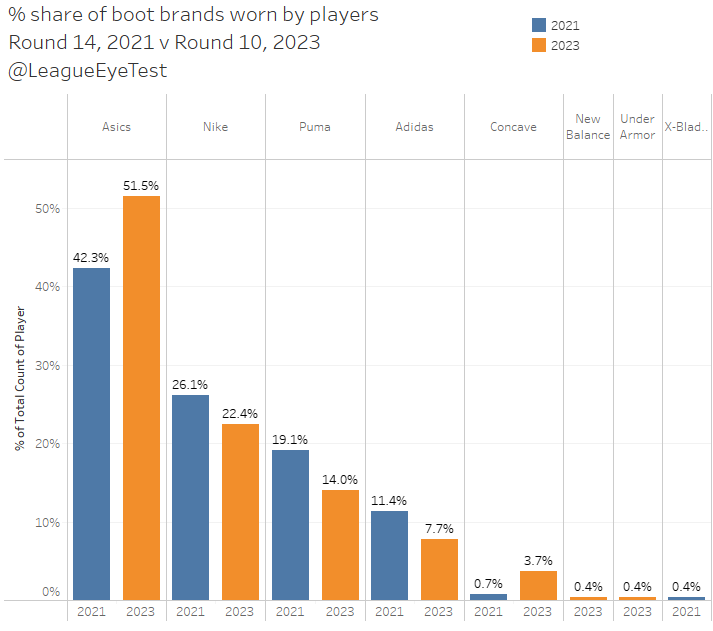
On the minus side, we’ve seen the exit of X Blades due to the standing down of it’s sole wearer, Luciano Leilua.
And whilst we have one brand leaving, we’re seeing two other brands represented for the first time on field at Magic Round. I’d alluded to it before on this site’s twitter account, but Eliesa Katoa was the only NRL player to wear Under Armor boots and he’s continued that this season with Melbourne. It’s pretty difficult to spot, as the model he’s wearing this season is 99% white and finding the identifying logo on a television camera is nigh impossible. Thankfully there’s plenty of still images available showing him wearing the same model he wore on Saturday evening.
The other new entrant to the NRL this season is New Balance, which are being worn by Manly’s Jason Saab.
There’s technically a third new entrant, with Newcastle’s Lachlan Miller being the only player I’ve ever seen wearing a pair of Mizuno boots (must be a union thing, or maybe he was a big Spud Webb fan – IYKYK). Sadly with the Knights not playing at Magic Round they’re not included in this data set but I’d be remiss to leave out such an important detail.
And we’re also seeing a sizable increase for another challenger brand in Concave. In 2021 the Australian owned company fielded just two NRL players – Ben Hunt and Jake Granville.
Fast forward to Magic Round 2023 and the company had 10 players sporting their boots on the weekend. That list still includes Hunt as it’s highest profile ambassador, as well as Granville, but they’ve also added Alex Johnston, Nick Meaney, Bronson Garlick, Erin Clark, Sione Katoa, Mathew Feagai, Jack Gosiewski and Tyrone Peachey. Melbourne’s George Jennings is also on their list but didn’t play on the weekend as he recovers from an ACL injury suffered last season, as was the case with Siliva Havili from Souths who also wears their boots.
It’s interesting to see a boot engineered for footballers (the global ones, not the Australian ones) start to take off in rugby league. Designed to “increase the ‘sweet spot’ (the area of the boot that makes contact with the ball) by approximately four times”, the boots have obvious advantages for the round ball game that are less useful for our great game.
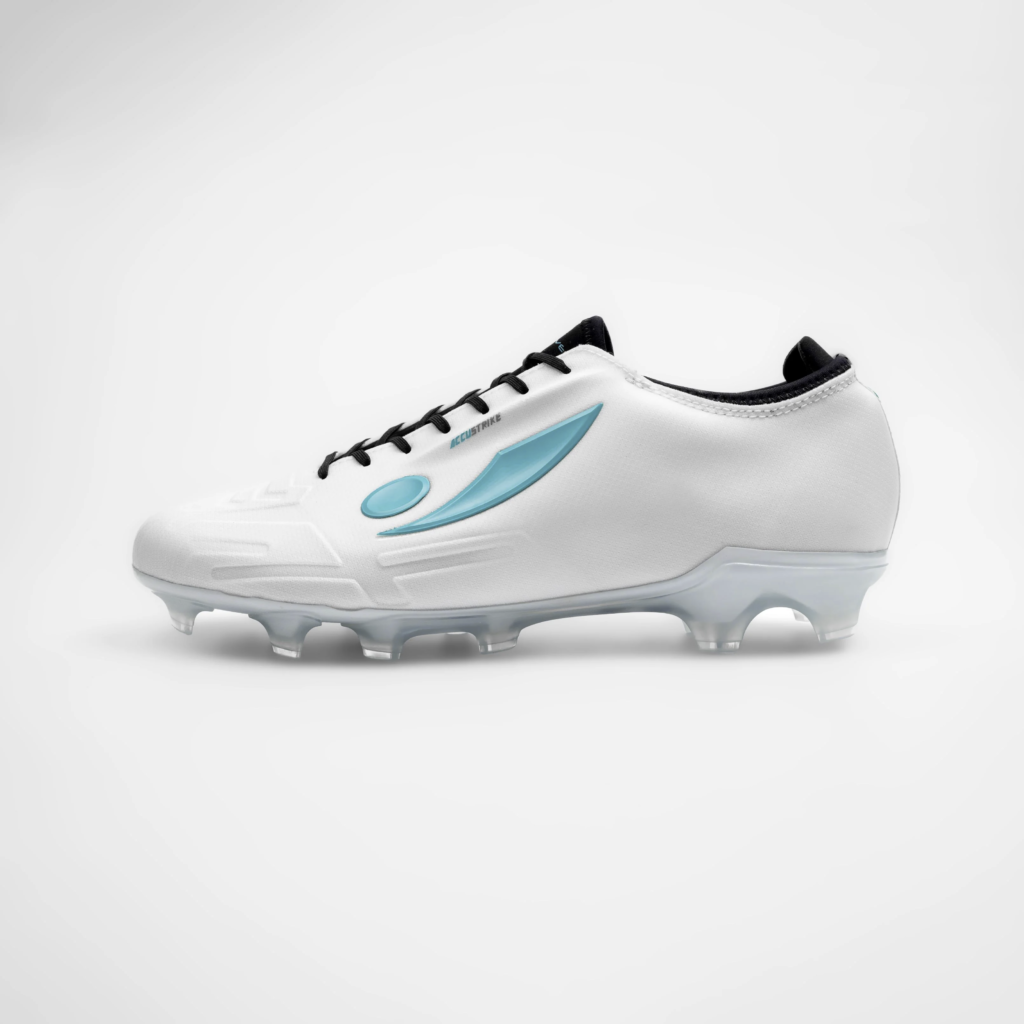
Concave’s 10 players represent about half of the number of players adidas had in Round 10 (21), which is an incredible result for a company that barely had a footprint in the game in 2021.
I’d also hope that Nick Meaney can get a bit more respect from the brand and have his name spelled correctly at some point soon.

We’ve now established what brands are being worn, but has there been a change in colourways of those brands?
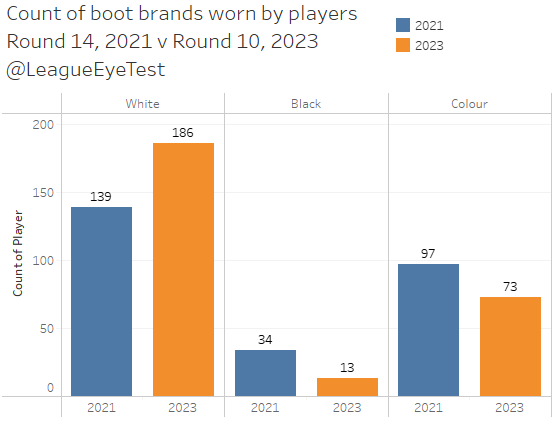
White boots are definitely the popular choice at the moment, with 186 players wearing white boots, up from 139 two seasons ago. The other big change is the near death of black boots. Just 13 players sported a majority black colourway at Magic Round, with most of those being from Asics. That number is down from 35 in 2021. Boots with a non black or white primary colour scheme also fell, but there were still 73 players wearing something other than black or white this weekend.
For percentages, that is 68% wearing white, up from 51%. Black dropped from 13% to 5% and coloured boots fell from 36% to 27%.

And whilst I didn’t log the main colour of every boot worn, just that they weren’t black or white, I did notice that the “in” colour this season seems to be blue. This was mainly in the way of Asics again, with a number of the Warriors side sporting a blue Asics boot.
The angry old men yelling at clouds about players wearing pink boots a few seasons ago will be pleased that pink seems to be very much on the outer, other than some accented colours on a few Adidas models worn.
What if we split these charts by backs & forwards?

Forwards love their Asics, with over 100 forwards wearing them in Round 10. Interestingly Nike has dropped in favour for the more agile backs, while Puma has dropped for the bigger players.
Looking at it by share makes the drops more obvious.
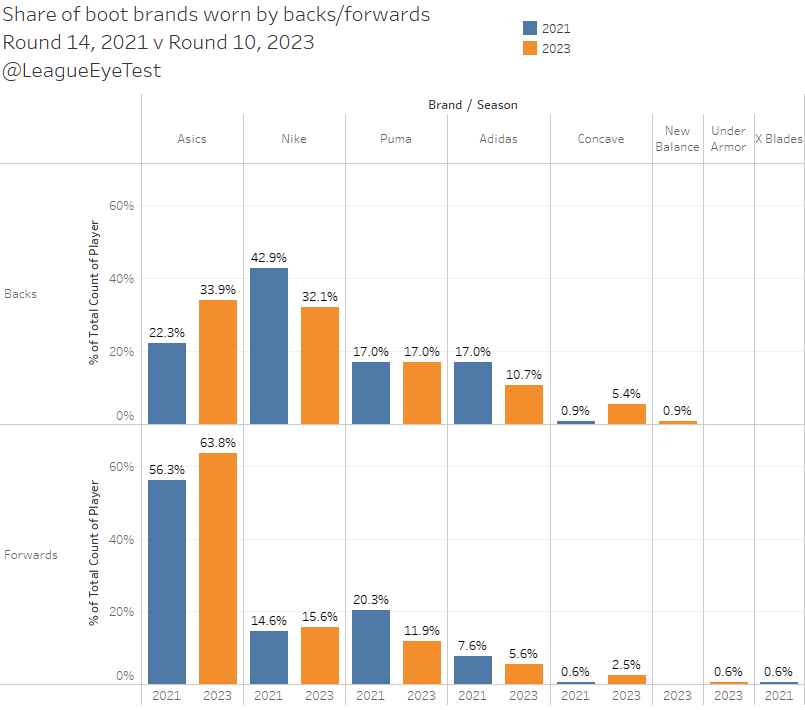
The drop of Nike for backs is an interesting one as they’ve often been the favourite of faster players whilst the wider and more accommodating Asics boots have been a mainstay of forwards. Nike’s share of back line players dropped from 43% to 32%, while Asics rose from 22% to 34% among those same players.
Are there any differences between forwards and backs for boot colours?

Not really, white boots are in and black and coloured boots are out.
Now let’s look at a brand share by team.

There’s a few things we can unpack here. The Warriors are the most dominant Asics team in the competition with 82% wearing that brand. Puma has the biggest hold on Melbourne and 29% whilst the Rabbitohs are the flagship Nike team with nearly half their players wearing the iconic swoosh.
Next let’s look at team colour share.
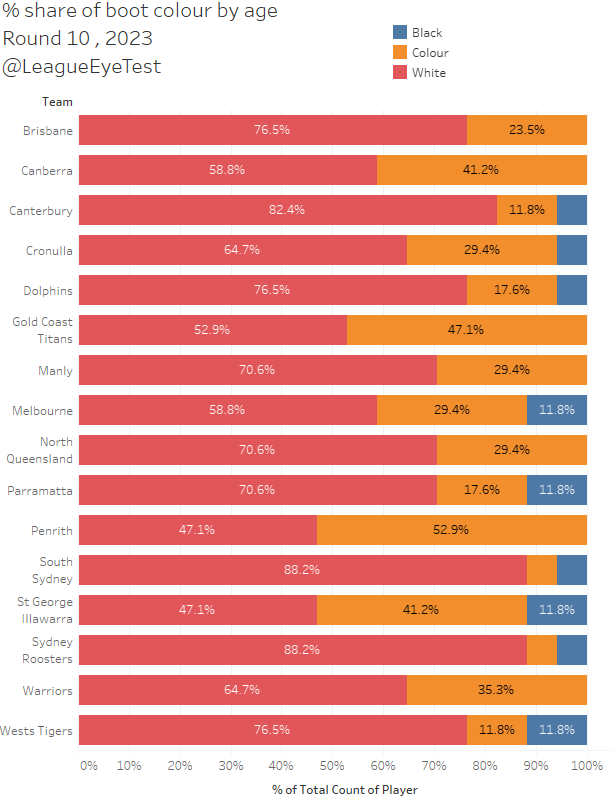
The Roosters and Bunnies are both nearly all white shoes, both at 89%. Penrith and St George Illawarra are the only teams with less than 50% of players wearing white boots, with the Panthers having the highest coloured boot share at 53%. Seven teams had zero players wearing black boots, something that people who grew up watching rugby league in the 60s and 70s may struggle to understand.
If we break down brands by age groups, is there a theme there? Are certain brands more popular with younger or older players?

There’s not a huge amount of insights here, other than Asics proving to be more popular with older players, Nike more popular with the under 22s and Puma having better share of the late 20s crew. The 30+ groups have small numbers so I’d treat them as more indicative of the players in those groups than representative (eg Jake Granville and Concave for 34+).
What if we looked at age groups? Are there any trends there?

Unsurprisingly the white boot movement is being driven by younger players, with over three quarters of players aged under 22 wearing white boots. This shouldn’t be a surprise to anyone who’s walked past a Hype, JD Sports or Platypus store recently. Older players tend to be wear coloured boots more, possibly a hangover from the fluorescent pink boot era.
During the two years since I’ve run this analysis, a number of high players have changed brands during these two years as well. Some of the bigger one include
- Alex Johnston – Adidas to Concave
- Brandon Smith – Adidas to Asiscs
- Cody Walker – Adidas to Nike
- Hamiso Tabuiai-Fidow – Adidas to Nike
- Jack Bird – Adidas to Nike
- Jason Saab – Nike to New Balance
- Joey Manu – Adidas to Nike
- Latrell Mitchell – Adidas to Nike
- Nicho Hynes – Adidas to Puma
- Reuben Garrick – Nike to Asics
- Nick Meaney – Adidas to Concave
- Tohu Harris – Nike to Asics
I think you can see a trend here. I wonder if any of the Adidas downfall is Ye related? Either way I wonder what the local staff at Adidas are doing (or probably not doing) that is causing such an exodus. Something like this would probably point to an influential contact leaving Adidas, and given the changes elsewhere, they’ve probably moved to Nike or Concave.
For the fantasy players, here’s the average Supercoach score by footwear brand for Round 10, 2023 vs Round 14, 2021.

Not a lot in this other than Puma being the only brand to have an average above 50 in 2023, which is more eventful for Nicho Hynes having a terrible weekend for owners.
And here’s the average Supercoach score by boot colour.
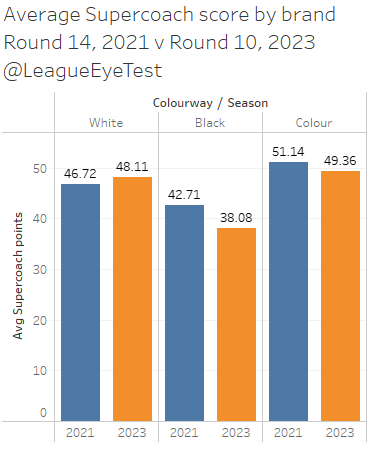
My advice is just don’t pick players who wear black boots. As noted above there’s only 13 of them so it’s not a difficult task.
With the numbers out of the way, I’d like to get to the other boot related part of this post, the surface at Suncorp stadium this weekend.
Two weeks ago there was already concern for the surface holding up for eight games.
By Friday evening the concern had reached such levels that everyone was asking the groundsmen if the field would hold up.
Now as the resident NRL boot expert, I could probably count on one hand the number of players who I’ve seen wear only screw in studs all season. There’s a reason they’re not popular which we’ll get to shortly.
Asking 280+ players to change the boots they’re comfortable with at short notice is hardly ideal given the surface quality. Professionally athletes can be notoriously superstitious and creatures of habit, so asking them to change their footwear at the last minute is probably going to be answered with a hard “no”.
Unfamiliar footwear is going to play with their confidence and depending on how different the boot is, also their footwork. In an era of marginal gains, every drop of performance you can extract from a player is vital.
In fact, even in Bojack’s follow up tweet, he confirms that club high performance units recommend moulded boots.
It’s worth reminding that James Tedesco doesn’t wear long studs for fear of injury. Screw in studs are generally longer than moulded ones, sometimes twice as much. Screw ins can range from about 180mm to 210mm, whilst most moulded boots have studs or blades in the range of 100mm to 120mm.
This is part of the reason why they offer better grip, as they’re digging into the surface further, but this can come at a cost of a higher injury risk with the increased grip causing more twisting on lower limbs. Meanwhile moulded studs being shorter and offering a blade style grip (see below) will more often slice through soft turn, as they did during the first game on Friday night.

Again, that type of behaviour is probably preferred from players and teams. It’s far better for the ground to give way than a tendon or joint.
There’s also a feeling from players that screw in studs are less comfortable, especially on harder pitches where the top (or is that bottom?) of the stud can be felt through the sole of the boot, sometimes causing bruising. Players with uncomfortable feet or sore feet won’t perform as well as those not having to worry about their footwork.
Screw in studs will provide better grip on wet and soft surfaces and moulded tend to shine best on dry surfaces, and generally will be more comfortable. Most manufacturers are offering hybrid boots these days, combining either screw in studs with moulded ones, or by adding a metal tip to the end of a moulded stud. You can see this below on the Nike Zoom Mercurial Vapor 15 Elite SG-Pro Anti-Clog Traction which Nike sells as a “soft ground boot”.

From all accounts they’re a great middle ground for unpredictable surfaces but are somewhat of a jack of all trades and master of none. Better than moulded but not offering the extra grip of screw ins. It looked like a number of players were wearing this variant of the Mercurial Vapor 15 Elite across the weekend as well as the tradition blade only version seen below. Other brands are also offering a similar technology.

Circling back to the injury risk, it turned out that all the pearl clutching was for naught as the surface resulted in one of the better rounds for serious injury rates, as noted by friend of the site and fin aficionado NRL Physio
It’s a topic he’s delved into before on his Patreon (please support him), and has noted that “natural grass that is slightly softer, wet and has some give is the surface with the lowest injury risk”, which is what we saw on the weekend.
He continues that “if this give or softness goes too far that can increase the risk of some injuries, but even in these cases the evidence suggests the injuries are rarely as severe.”
In the end the choice for players was to wear their usual footwear, chop up the turf and possibly lose their footing occasionally, or wear unfamiliar footwear with theoretically better grip but also the possibility of a slightly increased rate of serious injury.
It’s no surprise that many of them kept the status quo or wore a hybrid version for the reasons outlined above. And the lack of serious injuries out of that surface probably justified that decision, even if the parts of the turf looked like a more like a minefield than a rugby league field.
Maybe in twelve months time we can have some better pitch preparation that doesn’t require asking players to make significant changes to their playing kit with minimal notice.



